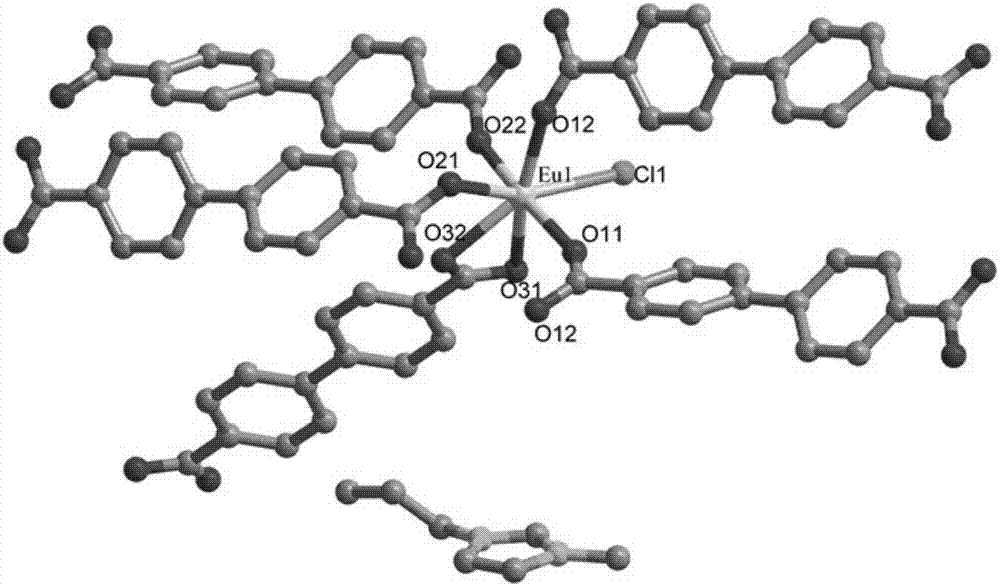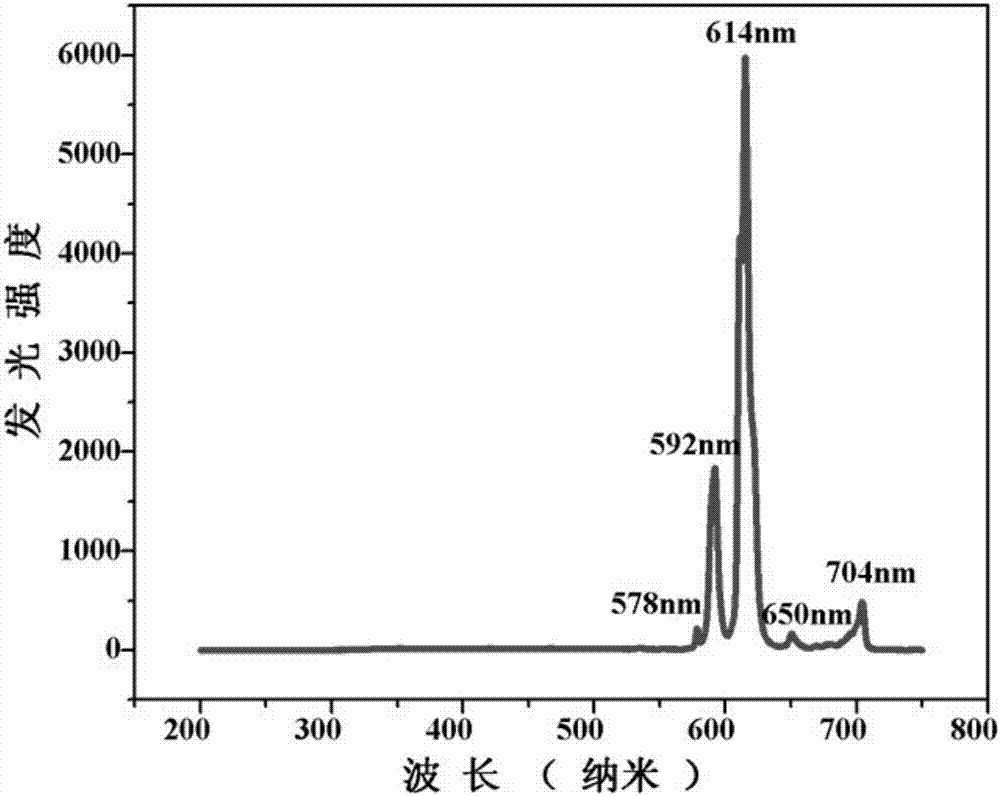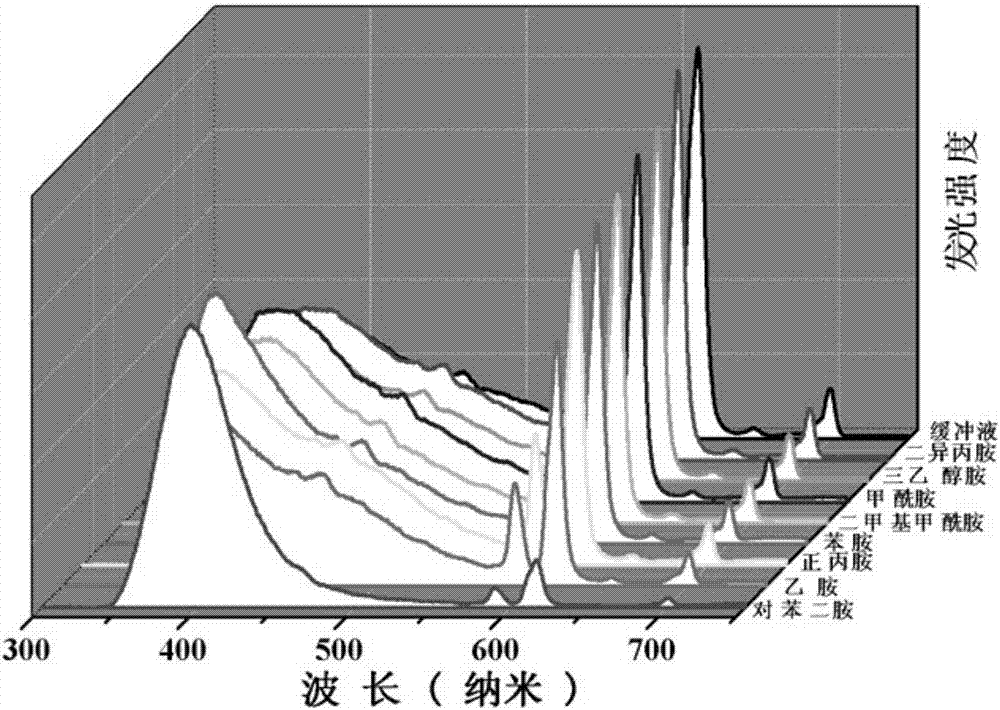Europium fluorescent probe and test paper based on diphenic acid and application thereof in the detection of p-phenylenediamine
A biphenyl dicarboxylic acid and fluorescent probe technology, applied in the directions of fluorescence/phosphorescence, luminescent materials, measuring devices, etc., can solve the problems of complicated operation, slow reaction, high cost, and achieve the effect of simple preparation method
- Summary
- Abstract
- Description
- Claims
- Application Information
AI Technical Summary
Problems solved by technology
Method used
Image
Examples
Embodiment 1
[0019] 0.1831g (0.5mmol) EuCl 3 ·6H 2 O, 0.0828g (0.5mmol) biphenyl dicarboxylic acid and 1.0mL chlorinated 1-ethyl-3-methylimidazolium ionic liquid were added in a 25mL polytetrafluoroethylene-lined reactor, mixed evenly, and then the reactor was placed In an oven, react at 170°C for 5 days, cool to room temperature, and wash with acetone and ethanol to obtain a colorless and transparent block-shaped europium fluorescent probe based on biphenyl dicarboxylic acid, whose structural unit is [PMI] 2 [Eu 2 (BPDC) 3 Cl 2 ], where PMI represents the monovalent cation of 1-propyl-3-methylimidazolium, and BPDC represents the biphenyl dicarboxylate that has lost protons on the two carboxyl groups, and belongs to the monoclinic crystal system with the space group P 2 1 / c, the cell parameters are: α=γ=90°, β=96.6830(10)°, unit cell volume Z=4. Such as figure 1 As shown, Eu1 adopts a seven-coordinated coordination mode, surrounded by four monoatomic bridged carboxyl groups, a d...
Embodiment 2
[0022] Grind 3 mg of the biphenyldicarboxylic acid-based europium fluorescent probe obtained in Example 1 and add it to 20 mL of dimethylformamide, stir evenly, and drop 5 μL of the resulting fluorescent probe suspension onto a circular filter paper with a diameter of 0.7 cm and dried at 70°C to obtain biphenyl dicarboxylic acid-based europium fluorescent probe test paper.
Embodiment 3
[0024] The application of the europium fluorescent probe test paper based on biphenyl dicarboxylic acid in the detection of p-phenylenediamine in the aqueous phase in embodiment 2
[0025] 1. Selective detection of p-phenylenediamine
[0026] Add 33.2 μL of triethanolamine, 19.3 μL of dimethylformamide, 0.0270 g of p-phenylenediamine, 22.7 μL of aniline, 12.0 μL of formamide, 20.8 μL of n-propylamine, and 35 μL of diisopropylamine into 25 mL of HEPES buffer with a pH value of 6.7. Propylamine and 14.3μL ethylamine were prepared into 10mmoL / L solutions of different organic amines; 20μL of the above solutions were respectively added dropwise to fluorescent probe test paper for fluorescence testing. The results show that when the HEPES buffer solution containing triethanolamine, dimethylformamide, aniline, formamide, n-propylamine, diisopropylamine and ethylamine is added dropwise on the fluorescent probe test paper, the fluorescence intensity of the fluorescent probe test paper ...
PUM
 Login to View More
Login to View More Abstract
Description
Claims
Application Information
 Login to View More
Login to View More - R&D
- Intellectual Property
- Life Sciences
- Materials
- Tech Scout
- Unparalleled Data Quality
- Higher Quality Content
- 60% Fewer Hallucinations
Browse by: Latest US Patents, China's latest patents, Technical Efficacy Thesaurus, Application Domain, Technology Topic, Popular Technical Reports.
© 2025 PatSnap. All rights reserved.Legal|Privacy policy|Modern Slavery Act Transparency Statement|Sitemap|About US| Contact US: help@patsnap.com



